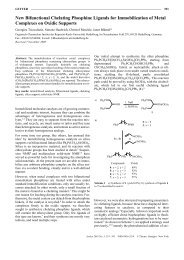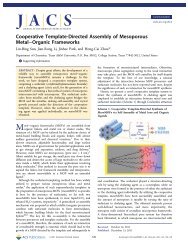Exam Final CHEM 466 120507 - Texas A&M University
Exam Final CHEM 466 120507 - Texas A&M University
Exam Final CHEM 466 120507 - Texas A&M University
Create successful ePaper yourself
Turn your PDF publications into a flip-book with our unique Google optimized e-Paper software.
Name:___________________________[printed]<br />
“On my honor, as an Aggie, I have neither given nor received<br />
unauthorized aid on this academic work.”<br />
<strong>Final</strong> <strong>Exam</strong>, May 7, 2012, 100 pts<br />
Polymer Chemistry, <strong>CHEM</strong> <strong>466</strong>, Spring 2012<br />
<strong>Texas</strong> A&M <strong>University</strong>, College Station, TX, USA<br />
________________________[signature]<br />
1. We discussed the use of poly(lactic acid) or polylactide in biomedical applications, such as in<br />
suture materials, and you’ve seen poly(glycolic acid) and polyglycolide on quiz #2. It is common<br />
for the properties of these two types of polyesters to be mixed, to obtain a polymer with<br />
intermediate crystallinity, hydrophobicity, mechanical properties and hydrolytic degradation rates,<br />
by the formation of copolymers that contain both types of repeat units along the polymer<br />
backbones. Consider only condensation, step-growth polymerization concepts, and reactions or<br />
side reactions that we have discussed for polyesters, to propose two quite different retrosynthetic<br />
routes that could be followed to give a mixed copolymer of lactic acid and glycolic acid repeat<br />
units. Work the retrosyntheses backward to the point that the forward syntheses begin from lactic<br />
acid and glycolic acid as the monomers, and provide the steps and reaction conditions that could<br />
be used to lead to the copolymer shown. Please note that your two approaches to this same<br />
copolymer structure may involve different numbers of steps. [20 points]<br />
HO<br />
O<br />
O<br />
x<br />
O<br />
O<br />
y<br />
n<br />
H
Name:___________________________[printed]<br />
2. Provide a retrosynthetic route for the poly(propylene imine) dendrimer structure shown below<br />
(copied from http://www.symo-chem.nl/dendrimer.htm). [10 points]<br />
2
Name:___________________________[printed]<br />
3. From the article Harth, E.; Hawker, C. J.; Fan, W.; Waymouth, R. M. Macromolecules 2001, 34,<br />
3856-3862:<br />
(a) Provide the starting materials and draw the forward sequence of electron arrow-pushing<br />
mechanistic steps for the preparation of the polystyrene structure, 12, below. Be certain to label<br />
the initiation, propagation and (reversible) termination steps. [10 points]<br />
3
Name:___________________________[printed]<br />
(b) What general type of polymerization is involved for the preparation of 12, [2 points]<br />
and what is the specific name for this particular sub-type of polymerization? [2 points]<br />
(c) List four characteristics of this specific type of polymerization: [4 points]<br />
(i)<br />
(ii)<br />
(iii)<br />
(iv)<br />
(d) Draw the typical DPn vs. % monomer conversion plots on the axes below for: [6 points]<br />
(i) condensation, step-growth polymerization<br />
(ii) uncontrolled addition, chain-growth polymerization<br />
(iii) controlled addition, chain-growth polymerization<br />
DP n<br />
0 100<br />
% monomer conversion<br />
4
(e) Reaction of the alkoxyamino terminus<br />
of polystyrene, 12, with<br />
a pyrene-substituted maleimide,<br />
16, afforded 17<br />
(+ ).<br />
Name:___________________________[printed]<br />
(i) Within the two boxes associated with the thermogravimetric analysis (TGA) traces of<br />
the following figure, assign which of the polymers was responsible for the TGA data<br />
by writing its compound number, 12 or 17. [2 points]<br />
(ii) Explain your answer to (i), in words and by showing the chemistry involved in the<br />
thermal degradation of the more thermally labile polymer. [4 points]<br />
5
Name:___________________________[printed]<br />
4. Provide a retrosynthetic analysis for the block copolymer of the cyclic diene 3methylenecyclopentene,<br />
2, and lactide, as reported in Kobayashi, S.; Lu, C.; Hoye, T. R. and<br />
Hillmyer, M. A. J. Am. Chem. Soc. 2009, 131, 7960-7961. [10 points]<br />
6
Name:___________________________[printed]<br />
5. (a) Evaluate and compare the following polymer structures to predict a ranking of their Tg values,<br />
with 1 being the highest and 3 being the lowest. [3 points]<br />
(b) Provide brief explanations for your predictions. [6 points]<br />
(c) State one product or application, in which each polymer is commonly employed. [6 points]<br />
Polymer Structure Tg ranking Explanation Typical<br />
product/application<br />
(for the application, state whether it<br />
is for low or high degree of branching)<br />
7
Name:___________________________[printed]<br />
6. Describe briefly the part of Professor Aida’s lecture on April 17, 2012 that you found most<br />
interesting, in terms of the application, the characteristics or properties of the materials that<br />
provided performance in that application, and the composition and structure of the materials. [15<br />
points]<br />
8
Equations, which may be of use:<br />
Number-average molecular weight:<br />
M NM N N # moles of polymer chains having molecular weight, M Weight-average molecular weight:<br />
M wM N <br />
M NM w wt fraction of polymer chains having molecular weight, M NM NM Degree of polymerization:<br />
DP 1<br />
1c<br />
c = extent of conversion of functional groups<br />
Polydispersity index:<br />
Critical extent of reaction:<br />
Average degree of monomer functionality:<br />
DP monomer ∙ % monomer conversion<br />
initiator ∙ f<br />
PDI M <br />
M <br />
p 2<br />
f <br />
f N f <br />
N <br />
Textbook:<br />
Hiemenz, P. C.; Lodge, T. P. Polymer Chemistry, 2 nd Edition; CRC Press, Taylor &<br />
Francis Group: Boca Raton, FL, USA, 2007


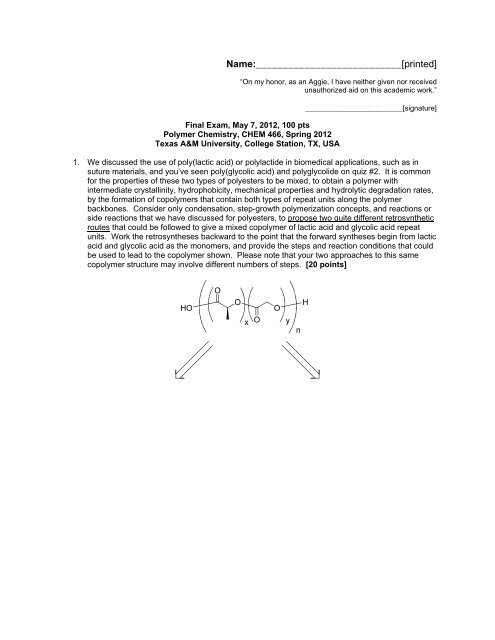
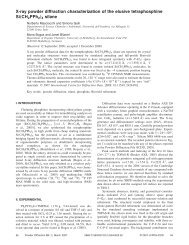
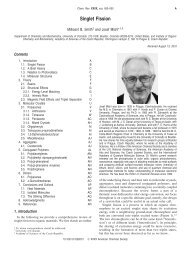
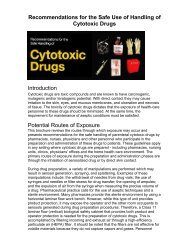
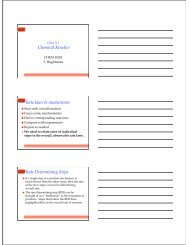
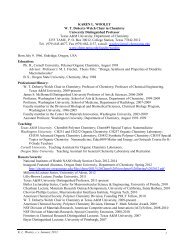
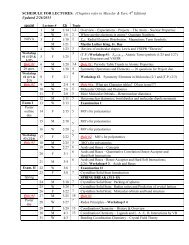
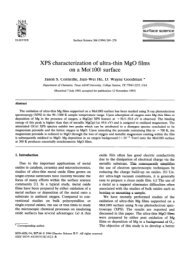
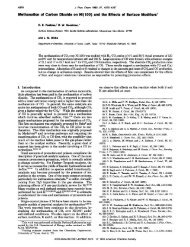
![Radical salts of TTF derivatives with the metal–metal bonded [Re2Cl8]](https://img.yumpu.com/10115211/1/190x253/radical-salts-of-ttf-derivatives-with-the-metal-metal-bonded-re2cl8.jpg?quality=85)



